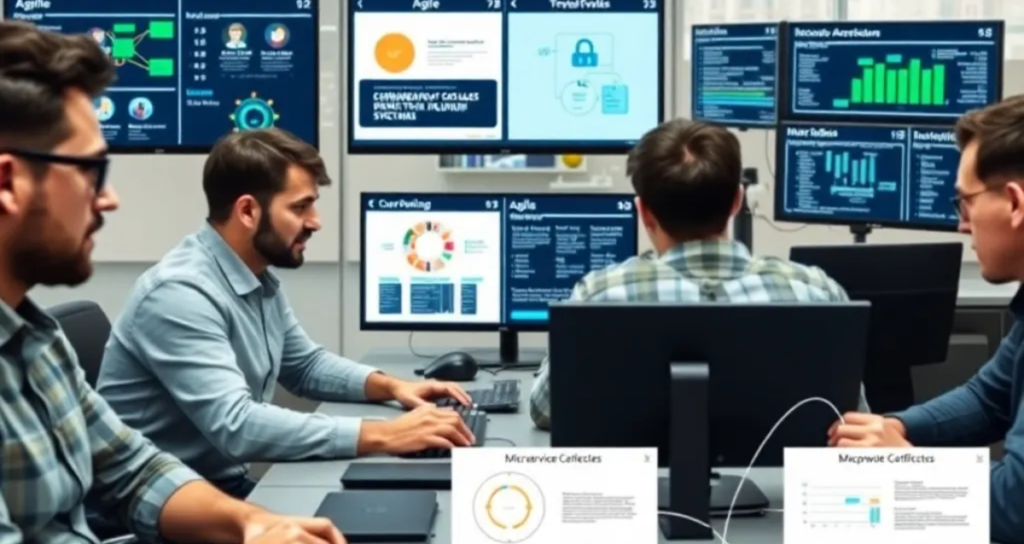Co-development software is transforming how companies operate in today’s fast-paced digital environment by allowing smooth worldwide team collaboration. It is like a well-organized building project where every specialist architect to electrician works harmonically to create something amazing. This strategy guarantees affordable solutions, stimulates creativity, and guarantees development speed, enabling companies to stay ahead in the competitive digital terrain.
Consider co-development tools as a group art project in which everyone contributes special talents such as coding, designing, or testing from whatever background. Different teams communicate ideas, give comments, and coordinate efforts to produce excellent software, just as painters, sketch artists, and sculptors collaborate to make a masterpiece. This approach closes gaps between sectors and encourages efficiency and originality in creating answers satisfying several demands.
Table of Contents
What is co-development software?
Co-development software is a set of tools and systems to support dispersed teams’ cooperation. It offers teams a centralized workspace to track development, exchange codes, coordinate efficiently, and handle the development lifetime. Co-development projects, several companies or teams collaborate to produce a shared software solution that relies on this tool.
What is a co in software development?
In software development, the term “co” often refers to teamwork or cooperation. It suggests cooperating with others inside one company or between several. This cooperative approach might manifest itself as:
- Co-creation: Together, developing fresh ideas or goods.
- Co-design: Working on software development and design.
- Co-development: Developing software together.
What is collaborative development in software engineering?
Collaborative software development, often referred to as co-development, is a methodology that emphasizes teamwork and cooperation among developers to create software solutions. It involves sharing knowledge, resources, and responsibilities to achieve a common goal. This approach contrasts traditional, siloed development practices, where developers work independently on isolated tasks.
Features of Co-development Programmes
Working with other teams helps companies access a greater pool of talent and information, therefore generating more creative and strong solutions.
- Faster Time-to-Market: Through parallel work, effective resource allocation, and faster decision-making, co-development may drastically cut development time.
- Lower Development Expenses: Shared resources, economies of scale, and effective cooperation contribute to minimizing general development costs.
- Risk Mitigating: Organizations can reduce possible hazards and mistakes by spreading risks across several partners.
- Improved invention: Cooperative settings inspire invention and creativity, resulting in original ideas and answers.
- The capacity to adapt and be flexible: Rigorous testing, code reviews, and common quality standards help to raise product dependability and quality. Co-development helps teams to react fast to shifting consumer wants and market expectations.
- Knowledge Sharing and Learning: Team member skill development and knowledge sharing are fostered via cooperative initiatives.
- Enhanced Cooperation: Based on mutual trust and common objectives, co-development can help to build solid alliances.
- Customer-Centric Solutions: Co-development involving several stakeholders helps to provide solutions more suited to consumer wants and expectations.
What Is the Process of Co-Development Software?
Co-development is collaborative development involving individuals, teams, or organizations creating or improving a product or service, especially in software development. Here is the Co-development software work:
- Determining the requirement: The first stage is spotting a particular software requirement or possibility that would profit from a team approach.
- Establishing Cooperative Partnerships: Choose appropriate partners depending on cultural fit, complementary abilities, and shared objectives.
- Setting Objectives and Scope: Clearly state the project’s aims, deliverables, deadlines, and performance criteria.
- Assigning Duties and Positions: Assign particular tasks and duties to every team member or partner to guarantee unambiguous ownership and responsibility.
- Providing Resources and Knowledge: Establish efficient channels of communication and knowledge-sharing systems to guarantee openness and cooperation through which knowledge and resources should be shared.
- The iterative development process: Using agile techniques will help enable quick development, regular feedback, and ongoing improvement.
- Managing Communication and Cooperation: Make flawless cooperation possible by using efficient tools and platforms regardless of distance.
- Convergence and Consensus Assurance: Frequent meetings, evaluations, and decision-making procedures assist in preserving alignment and consensus among all the stakeholders.
- Testing and Quality Assurance: Apply strict testing protocols to spot and fix flaws early in development.
- Installation and Upkeep: Coordinate the deployment and continuous maintenance of the software solution to guarantee timely upgrades and flawless functioning.
Crucial Attributes to Consider in Co-Development Software
Co-development software generally offers various features and functionalities specifically created to assist in collaborative software development procedures. These characteristics could consist of:
- Real-time Collaboration: Let code review and simultaneous editing run to promote effective cooperation.
- Revised Version Control: Track changes, handle disputes, and preserve code integrity through version control.
- Task Oversight: Track development, assign work, and monitor project schedules.
- Document Sharing and Storage: Organize and safely house project materials and documents.
- Communication Platforms: Messenger, video conferences, and chats will help you to promote good communication.
- Tailored Workflows: Tailor processes to particular project requirements and team preferences.
- Integration with Third-Party Tools: Elegantly link with other tools and services to improve output.
- Security Measures: Strong security measures help to protect intellectual property and private information.
- Reporting and Analytics: Create perceptive reports to monitor development, pinpoint areas of improvement, and maximize performance using analytics.
- Scalability and Reliability: Ensure the program can keep high availability and manage rising project requirements.
Applications Across Various Sectors
Co-development tools apply to several sectors, not just one. Across sectors, it’s a game-changer:
1. Development of Software: Creating intricate projects in groups
2. Automotive Sector: Creating next-generation car apps.
3. Aerospace: Developing methods of aircraft control.
4. Healthcare: Developing patient-care software and creative medical tools.
Obstacles and Remedies in Collaborative Development
Co-development software is beneficial yet difficult. Language and cultural obstacles may limit teamwork. This can be solved with translation tools, good communication, and cultural knowledge. Complex coordination, especially among distant teams, can degrade efficiency. Project management tools and clear coordination may speed up and align activities. IP concerns must be addressed and safeguarded.
Avoiding team disagreements and delays caused by divergent expectations requires open communication and decision-making. Different platforms and development tools might generate technical issues. Choosing appropriate tools and standards reduces these risks. Budget constraints and skilled personnel shortages may hinder project progress. Prioritizing tasks and allocating resources can solve these challenges. Finally, cultural variations and collaborative norms may inhibit teamwork. A culture of respect and trust may bridge these gaps and improve collaboration. Companies may optimize co-development by proactively addressing these issues. Launching Software Development Revolution
Optimal Strategies and Advice for Executing Co-Development Software
Clearly state the aims and results of the co-development initiative.
- Early involvement of all pertinent stakeholders guarantees alignment and buy-in from the start.
- Choose a co-development software solution that fits the particular requirements of the project.
- Give team members thorough instruction and assistance to utilize the program efficiently.
- Create effective lines of communication to enable knowledge exchange and teamwork.
- Advance a cooperative culture that supports knowledge exchange, open communication, and team building.
- Create customized procedures that fit the particular requirements of the team and project.
- Organize frequent meetings and reviews to monitor development, handle problems, and guide choices.
- Provide chances for team members to exchange best practices and information.
- Track development and pinpoint areas needing work employing statistics and analytics.
- Respond to comments and iteratively enhance the product using the suggestions of stakeholders.
- Keep adaptive to shifting conditions and welcome a flexible attitude to growth.
Co-Development vs Conventional Development
| Aspect | Co-Development | Conventional Development |
| Approaches | Independent | Cooperative |
| Stakeholder Involvement | Many companies | One company |
| Resource Sharing | Yes | No |
| Innovation | Higher due to diverse inputs | Limited to in-house capabilities |
| Risk and Reward Sharing | Mostly for the company | Solely on the organization |
Latest Trends in Collaborative Software Development for Co-Development Software

Software Co-Development’s latest trends here are:
1. Open source adoption: The adoption of open-source tools and frameworks for cooperative development should rise.
2. Integrating Agile and DevOps: Integrating agile approaches with DevOps techniques helps speed development and raise quality through mutual acceleration.
3. Cloud development environment: Using cloud computing and cloud-based platforms for flexible resource allocation and remote collaboration will help create environments for development.
4. Cross-functional teams: Creation of cross-functional teams with varied expertise to handle difficult problems
5. The architecture of the microservice: Adoption of microservice architecture helps to provide modular development and autonomous deployment.
Tools Supporting and Strategies for Co-Development
Effective co-development depends on widely used platforms such as GitHub, Jira, and Slack. These tools are essential for group projects as they provide version control, communication, and task management tools. Want to maximize co-development tool capabilities? Apply these techniques:
- Agile Development: Work in short, iterative cycles in agile development.
- Rapid prototyping: Test concepts many times and early on.
- CI/CD Pipelines: Program automatic testing and deployment.
Future Developments
Co-development software has a very bright future. Look for patterns like:
• Integration of artificial intelligence: automating labor-intensive chores
• Cloud Cooperation: Availability of instruments for worldwide teams.
• IoT Revolution: perfect device connection.
• Improved Cybersecurity: Digital era data protection.
Real-World Examples of Collaborative Development
- Open-Source Software: Open-source projects like Linux and Apache are prime examples of successful collaborative development. A global community of developers contributes to these projects, sharing code, expertise, and resources.
- Agile Methodologies: Agile methodologies like Scrum and Kanban promote collaboration and teamwork. They emphasize frequent communication, iteration, and continuous improvement.
- Remote Teams: Collaborative tools and platforms enable teams to work together effectively, regardless of geographic location.
- cross-industry application: A health company and technology company collaborated to create a revolutionary medical gadget, facilitated by co-development tools, enhancing patient treatment through easy cooperation between medical professionals and software engineers.
- Enterprise-Level Change: A large company utilized co-development tools to streamline software development operations, saving money and improving product quality by breaking down complex projects into manageable tasks.
By embracing collaborative software development, organizations can create high-quality software, foster innovation, and improve overall team productivity.
Final Thought
Co-development software transforms how companies approach challenging tasks and generate innovative ideas in a time marked by cooperation and invention. Encouraging flawless teamwork helps companies reduce organizational and regional gaps, speeding development cycles and improving effectiveness. For businesses in many different sectors, co-development is a strategic advantage, including faster time-to-market, lower costs, and better quality.
Co-development software also enables different teams to exchange expertise, invent together, and rapidly adjust to evolving market needs, in addition to streamlining the technical elements of teamwork. Driven by developments such as artificial intelligence integration, cloud-based platforms, and improved cybersecurity, co-creation software is likely to be very important in the direction of software development. Adopting co-development software is not only a need but also a decision that companies trying to survive in today’s competitive scene must make.
Frequencies of Questions
1. What is co-development software?
Collaborative software creation, task management, code sharing, and communication streamlining all find a forum in co-development software.
2. Why is co-development relevant?
Sharing resources and skills leads to new ideas, cuts costs, and speeds up growth.
3. What distinguishes co-development from more conventional approaches?
While conventional approaches depend on in-house teams, co-development stresses cooperation across several companies.
4. What are the key features of co-development software?
Version control, task management, secure file sharing, scalability, and real-time collaboration.

